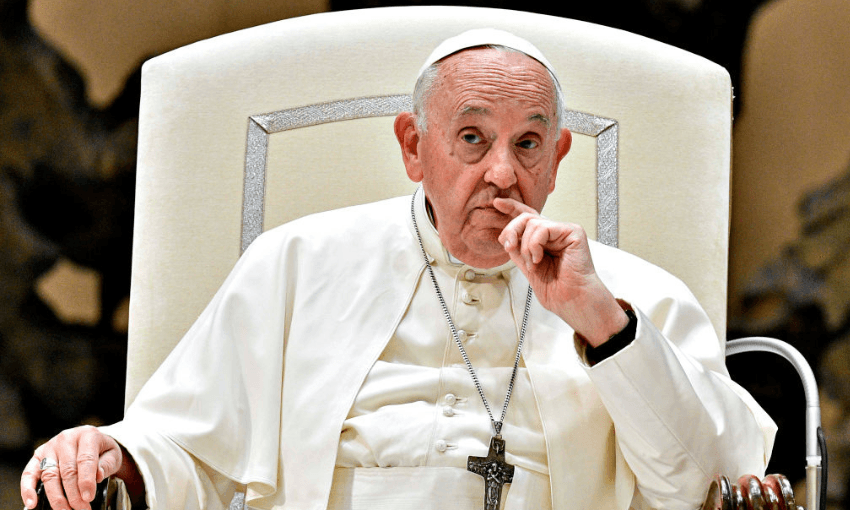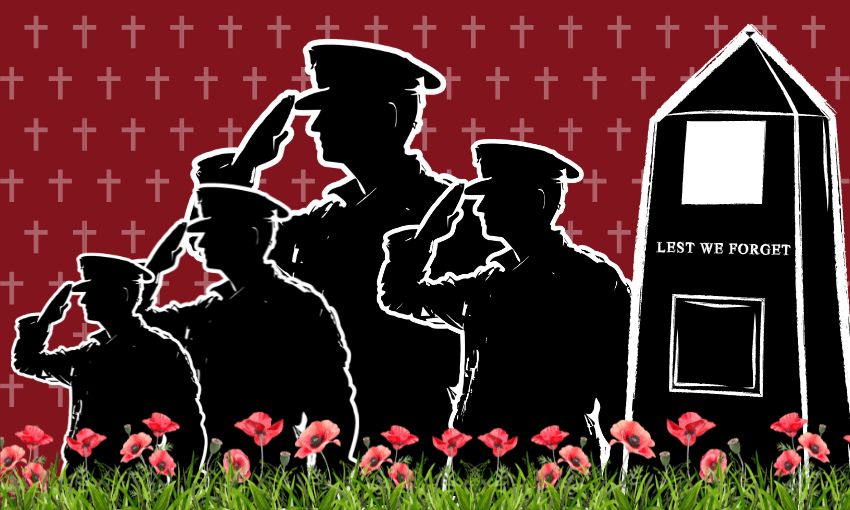The conclave explained, a cinematic knowledge shortcut and very scientific musings about a possible curse.
Gather round atheists, agnostics, apathetes, anyone who hasn’t seen Conclave and all who have successfully rinsed their religious education from their memories.
Pope Francis, the first pope from Latin America, the first from the Jesuit order and the first of his papal name, died on Easter Monday.
There are numerous reasons for letting this event pass you by. Half the population of New Zealand has no religion. The wealthy and powerful institution popes lead has turned a blind eye to horrific abuse and still uses its power to maintain damaging and regressive doctrine. To practising Catholics worldwide, however, Pope Francis was a spiritual leader and by all known accounts, a humble man who lived a life of service. Since his death it’s been reported that one of his regular evening rituals over the last 18 months was calling the only Catholic church in the Gaza Strip to see how they were coping.
If you laid out the column inches dedicated to the pope’s death and upcoming related events, pointed them towards the sky, and climbed them like a ladder, you would get close to touching the cloud Queen Elizabeth II appeared in after her death. The pope’s global profile is on par with that of world leaders and royalty, and his death is internationally significant. It’s also the starting point for the pageant-like yet secretive process known as the papal conclave.
First things first, who was Pope Francis?
Born Jorge Mario Bergoglio in Buenos Aires, Argentina, he was elected pope in 2013. He spoke often about caring for the poor, the need to tackle climate change, the plight of migrants and encouraged interfaith dialogue. As far as popes go, he was considered progressive and inclusive, succeeding Pope Benedict XVI, who was generally regarded as a defender of more traditional Catholic doctrine. He chose Francisco as his papal name to honour Saint Francis of Assisi, eschewed papal pomp and trimmings, appearing in white robes instead of the ermine-trimmed papal cape when he was first introduced as pope, and did not live in the Vatican penthouse like his predecessors.
What happens now?
A few big things have already happened. News.com.au broke the story of the year by informing us that the pope died 90 minute after his alarm went off, accompanied by a photo that looks like he just read that headline. A doctor has certified his death, and his cause of death has been announced. The camerlengo (cardinal chamberlain) has used a ceremonial hammer to destroy the pope’s ring. The door of the pope’s study has been sealed. Two things have yet to unfold, but both involve large gatherings of men in red frocks (the cardinals).
The procession, viewing, funeral and burial
The first significant event is Pope Francis’s funeral. This will take place on Saturday, April 26 at 10am local time (8pm NZT). His body is currently in the chapel of Casa Santa Marta. A procession to St Peter’s Basilica will begin at 9am local time on Wednesday (7pm in New Zealand). Previous popes have been raised high onto platforms, their Russian doll style caskets — three coffins inside each other made of lead, cypress, and elm — draped in gold cloth. Pope Francis has opted for pared back proceedings in line with his humbler approach to the papacy. He will lie in an open casket at St Peter’s Basilica in the Vatican City where mourners will process over the next few days and be able to look at him. He has also opted for a simple wooden casket lined with zinc. He has also made arrangements to be buried in Rome’s Basilica of St Mary Major, the first pope in over 100 years not to be buried in the crypt at St Peter’s Basilica.
What is the conclave, and who can vote?
The conclave is how a new pope is elected. They can drag on but are usually instigated quickly, 15-20 days after a pope’s death. A pool of cardinals elects popes. There are 252 cardinals, but only 135 can vote in a conclave to elect a new pope. They are called cardinal electors and must be under the age of 80. During his papacy, Pope Francis chose about 110 of them, so his lean towards inclusivity rather than the more conservative wings of the Catholic church could be reflected in who gets elected.
How does the voting work?
The cardinal electors are locked inside the Sistene Chapel. They are not allowed to make contact with the outside world. There is no news, TikToks, or live blogging about the event they’re engaged in. No broadcasting, media or phones are allowed, so this event is an anamoly in today’s live-streamed world. The cardinals participate in rounds of voting by ballot paper until a two-thirds majority is reached. Votes are taken twice a day. There are breaks for prayer, reflection, food and sleep. They stay nearby at their custom accomodations, Domus Sanctae Marthae.
The ballots are burned, and chemicals are added to change the colour of the smoke billowing out of the Vatican chimney. Black smoke means no pope has been elected yet. White smoke means Cardinal Mufasa will soon emerge and say, “Habemus Papam” (we have a new pope). Pope Simba, who will not be called that by the time he gets to the balcony because popes choose a papal name, will appear, wave, and speak. Pope Francis greeted his crowd with a simple “Buona sera”.
What is happening in New Zealand to mark the pope’s death?
Prime minister Christopher Luxon has paid tribute to Pope Francis, calling him a “man of humility.” He said, “His legacy includes an unwavering commitment to the vulnerable, to social justice, and to interfaith dialogue. My thoughts are with Catholics and all those in New Zealand and around the world who mourn his death.” A spokesperson for the prime minister said a decision would be made about New Zealand representation at Pope Francis’s funeral once details of the funeral have become clear. Luxon is currently in the United Kingdom and is due to travel to Gallipoli to mark Anzac Day later this week.
Labour leader Chris Hipkins said, “Throughout his papacy, [Pope Francis] showed deep compassion and an unwavering commitment to social justice, inclusion, and the dignity of every person. His leadership challenged us all to build a fairer and more caring world.”
Catholic churches around the country are holding special masses and flags are being flown at half mast.
The Sky Tower lights were turned off last night and will remain off tonight, a choice that might prompt questions rather than inspire reverence, but now you know.
Did a visit from JD Vance have anything to do with Pope Francis’s death?
Nobody but Francis knows how coming face to face with the US vice president impacted his health, physical or otherwise. Vance does have a habit of just popping up in places. Francis’s official cause of death was a stroke, causing a coma and “irreversible” heart failure. He had a history of respiratory illness and had part of one lung removed when he was 21.
Caring for those who travel to other countries was a regular talking point throughout Francis’s papacy. Despite his insistent focus on a specific type of traveller (those often fleeing war-torn regions hoping to build a new life), we can only assume that the pope took a visit from someone travelling on the taxpayer dime in his stride. Having said his piece on the Trump administration’s deportation policies in February, we also can only assume that Pope Francis had mixed feelings about leaving us to it with a US vice-president who once gave credence to “reports” that “showed” Haitian immigrants were abducting and eating household pets.
Where is the pope now?
If you adhere to Catholic doctrine, the holy father is now in heaven. See above for where his body is.
Coincidentally, if you adhere to Church of England doctrine, Queen Elizabeth II (who was visited by Liz Truss two days before she died and 44 days before Truss resigned as UK prime minister) is also in heaven.
If you listen carefully over the next few days, you may detect a faint but audible sound in the air. It could be the makings of an extrapolated but fun theory about the curse of visitations by populist political figures. It might also be a productive celestial hum as a sacred list of those who will be smote if they get within a kilometre of Sir David Attenborough is hurriedly compiled.
Can I just watch Conclave and let Ralph Fiennes and Stanley Tucci educate me?
Yes. My apologies on having to read this far to get the hack. According to some theologians, the 2024 film is a pretty good depiction of the conclave process. Aside from a camp factor as high as an assumed Mary and discrepancy around the voting rights of cardinals appointed in pectore (in the heart), the film didn’t get badly mauled by those who know how the process goes.
There really is an order of nuns who tend to the cardinals while in conclave. Due to the status women are afforded in the Catholic church, they are meant to stay silent, so the odds of an Isabella Rossellini-esque figure popping up are low. Photography is prohibited so regretfully we will not be privy to evidence of a cardinal hooning on a fruity vaporesso.
To round out your holey knowledge of papal life and what happens during a conclave, you could also watch The Two Popes, written by New Zealander Anthony McCarten. For a trippier, more surreal experience starring Jude Law and John Malkovich, try The Young Pope and The New Pope.

